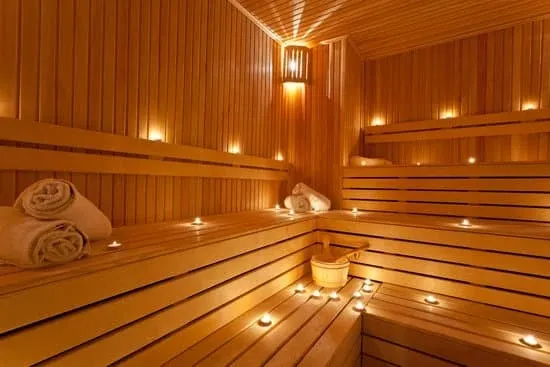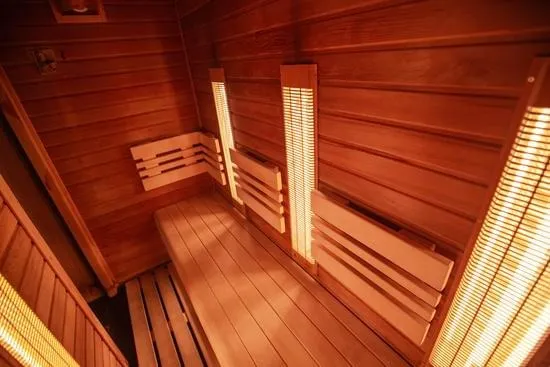The Complete Guide to Infrared Indoor Saunas

If you're considering adding a sauna to your home, infrared technology offers a modern approach to this ancient wellness practice. Over the past 15 years, I've watched infrared saunas transform from a niche product to a mainstream wellness solution, and for good reason.
Unlike traditional saunas that heat the air around you, infrared saunas use light waves to heat your body directly. This creates a gentler, more penetrating heat that many find more comfortable and therapeutic. Let me walk you through everything you need to know about infrared indoor saunas so you can make an informed decision.
What is an Infrared Sauna?
An infrared sauna uses specialized heaters that emit infrared light waves. When these waves hit your skin, they're absorbed by your body, creating heat from within. Think of it like standing in warm sunlight—you feel the warmth without the air temperature being extremely hot.
There are three types of infrared waves used in saunas:
- Near-infrared: Penetrates the skin's surface, promoting wound healing and skin rejuvenation
- Mid-infrared: Reaches deeper into soft tissue, improving circulation and pain relief
- Far-infrared: Penetrates deepest, raising core body temperature and promoting detoxification
Most modern saunas combine all three wavelengths for comprehensive benefits. If you're exploring various wellness solutions, you might also want to check out different infrared sauna options available to understand the range of products on the market.
Health Benefits of Infrared Saunas
The science behind infrared saunas is compelling. According to research published by the National Institutes of Health, regular sauna use offers significant cardiovascular benefits comparable to moderate exercise.

1. Cardiovascular Health
Infrared sauna sessions can improve circulation and lower blood pressure. A study from the University of Eastern Finland found that men who used saunas 4-7 times per week had a 50% lower risk of fatal cardiovascular events compared to those who used them once weekly. For a deeper look at how heat therapy supports your circulatory system, explore our article on infrared sauna blood circulation benefits.
2. Detoxification
The deep-penetrating heat promotes profuse sweating at the cellular level, helping your body eliminate toxins including heavy metals, environmental chemicals, and metabolic waste products. You'll sweat more at lower temperatures compared to traditional saunas.
3. Pain Relief and Muscle Recovery
Infrared heat increases blood flow to muscles and joints, reducing inflammation and accelerating recovery. Many athletes and physical therapists recommend infrared saunas for managing chronic pain conditions and post-workout recovery. Learn more in our comprehensive guide on sauna therapy for muscle recovery.
"After incorporating infrared sauna sessions into my recovery routine, I noticed significant improvements in muscle soreness and overall flexibility. It's become an essential part of my wellness toolkit." - Professional athlete testimonial from our studio
4. Stress Relief and Mental Wellness
The gentle warmth promotes relaxation and can help reduce cortisol levels. Regular users often report better sleep quality and improved mood. The quiet, meditative environment provides a perfect escape from daily stressors. Discover how heat therapy can transform your mental wellbeing in our article about sauna for stress relief and mental wellness.
5. Skin Health
Increased circulation brings more nutrients to the skin while sweating helps purge impurities. Many users report improved skin tone, reduced wrinkles, and clearer complexion with consistent use. For the full story on how sauna can rejuvenate your complexion, read our guide on sauna benefits for skin health and anti-aging.
Types of Infrared Indoor Saunas
| Type | Size | Price Range | Best For |
|---|---|---|---|
| Portable | 1 person | $200-$600 | Renters, small spaces |
| Cabinet (1-person) | 3x4 feet | $1,500-$3,000 | Individual use, tight budgets |
| Cabinet (2-person) | 4x5 feet | $2,500-$4,500 | Couples, small families |
| Cabinet (3-4 person) | 5x6 feet | $4,000-$6,000+ | Larger families, entertaining |
Choosing the Right Size
Size matters when it comes to saunas. Here's what I recommend based on your situation:
One-Person Saunas
Perfect if you're the primary user and space is limited. These typically measure 3-4 feet wide by 3-4 feet deep. They're energy-efficient and heat up quickly, making them ideal for busy schedules.
Two-Person Saunas
The most popular choice for homes. At roughly 4-5 feet wide by 4-5 feet deep, they accommodate couples comfortably while fitting in most bathrooms or spare rooms. Check out our guide on two-person indoor saunas for more detailed information.
Larger Models
Three to four-person models work well for families or those who entertain. They require more space (typically 5x6 feet or larger) but create a communal wellness experience.
Need Expert Guidance?
Get personalized recommendations for your space and budget.
Installation Requirements
One of the beauties of infrared saunas is their relatively simple installation compared to traditional saunas.
Electrical Requirements
- Small units (1-2 person): Often work with standard 120V outlets
- Larger units (3+ person): May require 240V dedicated circuits
- Power consumption: Typically 1,600-3,000 watts depending on size
Always hire a licensed electrician to assess your electrical system. According to the National Fire Protection Association, proper electrical installation is crucial for safety and warranty validity.
Ventilation
While infrared saunas don't require extensive ventilation like traditional saunas, some airflow is still necessary. A gap under the door or a small vent ensures comfort and prevents excessive humidity buildup.
Location Considerations
Popular locations include:
- Master bathrooms (convenient for showering after)
- Spare bedrooms or home offices
- Basement rec rooms
- Enclosed porches or patios
Ensure your chosen space has solid flooring that can support the sauna's weight plus occupants (typically 500-800 pounds total).
Cost Breakdown
Let's talk numbers. Understanding the full cost helps you budget appropriately:
Purchase Price
- Budget-friendly: $1,500-$2,500 (basic features, smaller size)
- Mid-range: $2,500-$4,000 (better quality, more features)
- Premium: $4,000-$6,000+ (high-end materials, advanced features)
Installation Costs
- Electrical work: $200-$800 (if needed)
- Delivery and setup: $100-$300
- Flooring preparation: $0-$500
Operating Costs
Infrared saunas are remarkably energy-efficient. A typical 30-minute session costs about $0.30-$0.50 in electricity, or roughly $10-$20 per month for regular use.
Key Features to Look For
When shopping for an infrared sauna, these features can significantly impact your experience:
Carbon vs. Ceramic Heaters
Carbon heaters provide more even heat distribution and operate at lower surface temperatures, making them safer and more comfortable. Ceramic heaters heat up faster but may create hot spots. Most premium saunas use carbon heaters or a combination of both.
Wood Quality
Common woods include:
- Cedar: Naturally aromatic, resistant to moisture and insects
- Hemlock: Neutral scent, affordable, hypoallergenic
- Basswood: Soft, comfortable, low-odor
Control Systems
Look for digital controls with preset programs, temperature adjustment, timer functions, and ideally, smartphone app integration for remote control and session tracking.
Additional Features
- Chromotherapy (color light therapy) - enhances the wellness experience
- Built-in sound systems
- Reading lights
- Oxygen ionizers
- Ergonomic backrests
How to Use Your Infrared Sauna
Getting the most from your sauna requires following some best practices:
Before Your Session
- Hydrate well—drink 16-20 oz of water
- Remove jewelry and contact lenses
- Take a quick shower to remove lotions or oils
- Bring a towel to sit on and one to wipe away sweat
During Your Session
- Start with 15-20 minutes if you're new to saunas
- Gradually increase to 30-45 minutes as your body adapts
- Set temperature between 120-140°F
- Relax, meditate, or listen to calming music
- Exit immediately if you feel dizzy or uncomfortable
After Your Session
- Cool down gradually—don't rush into a cold shower
- Rehydrate with water or electrolyte drinks
- Take a lukewarm shower to rinse off toxins
- Rest for 10-15 minutes to let your body temperature normalize
Maintenance and Care
Infrared saunas require minimal maintenance, but a little care goes a long way:
- After each use: Wipe benches with a clean towel
- Weekly: Vacuum the floor and wipe interior surfaces
- Monthly: Clean glass doors and panels with appropriate cleaner
- Annually: Inspect heaters and electrical connections
For more detailed maintenance guidance, visit our article on maintaining your indoor sauna.
Common Concerns Addressed
Is Infrared Radiation Safe?
Absolutely. Infrared light is part of the natural light spectrum—the same type of heat you feel from sunlight without the harmful UV rays. The Harvard Medical School confirms that infrared heat is safe for regular use.
Can I Use It Every Day?
Yes, many people use infrared saunas daily without issues. Start with 3-4 times weekly and increase as your body adapts. Always listen to your body and consult your doctor if you have health concerns. Regular use can also help boost your immune system.
Will It Help Me Lose Weight?
While you'll lose water weight through sweating, infrared saunas aren't a magic weight loss solution. However, the cardiovascular benefits may support a healthy weight management program when combined with proper diet and exercise. For a realistic look at this topic, see our article on sauna for weight management and metabolism.
Making Your Decision
Choosing an infrared indoor sauna is a significant investment in your health and wellbeing. Consider these final points:
- Budget realistically: Include installation and operating costs
- Measure carefully: Ensure your space can accommodate the sauna
- Research brands: Read reviews and check warranty coverage
- Consider features: Decide which features matter most to you
- Think long-term: Quality construction pays off over years of use
For help comparing infrared saunas to other options, read our comprehensive guide on choosing the best indoor sauna for your home.
Ready to Transform Your Wellness Journey?
Get personalized guidance on choosing the perfect infrared sauna for your home. Our experts are here to help you make the right decision.
Frequently Asked Questions
An infrared sauna uses infrared heaters that emit light waves to heat your body directly rather than heating the surrounding air. This creates a gentle, penetrating heat that warms you from within at lower temperatures (typically 120-140°F) compared to traditional saunas.
Infrared saunas offer numerous benefits including improved cardiovascular health, enhanced detoxification, pain relief and muscle recovery, stress reduction, better sleep quality, skin rejuvenation, and potential weight management support.
Infrared saunas range from $1,500-$5,000 for pre-built models. Budget-friendly options start at $1,500-$2,500, mid-range models cost $2,500-$4,000, and premium saunas with advanced features run $4,000-$6,000+.
Start with 15-20 minute sessions and gradually increase to 30-45 minutes as your body adapts. Most people benefit from 3-4 sessions per week. Always listen to your body and stay hydrated.
References
- National Institutes of Health. (2015). "Cardiovascular and Other Health Benefits of Sauna Bathing"
- Harvard Medical School. "Harvard Health Publishing - Wellness Research"
- National Fire Protection Association. "Electrical Safety Standards"
- Mayo Clinic. "Sauna Health Benefits and Safety Guidelines"




